
Boa Constrictors are fascinating and rewarding pets for intermediate-level reptile enthusiasts. With suitable habitat, appropriate diet, and proper veterinary care, these impressive snakes can make wonderful and engaging companions for years to come.
Here we have provided a comprehensive guide on caring for boa constrictors.
Table of Contents
Boa Constrictor Facts
| Common Name | Boa constrictor |
| Scientific Name | Boa constrictor spp. |
| Natural Habitat | Central and South America |
| Adult Size | Females: 7 – 10 ft Males: 6 – 8 ft |
| Enclosure Size | 72” x 24” x 24” |
| Diet | Mice, rats, rabbits |
| Lifespan | 20 – 30 years |
| Experience Level | Intermediate |
Where Do Boa Constrictors Live?
Boa constrictors are native to Central and South America. They can be found in a variety of habitats including rainforests, savannas, and semi-arid regions.
Boas can swim well and are semi-arboreal creatures, spending much time on tree branches when they are young. As they get older, they become mostly terrestrial.
Boa Constrictor Appearance and Colors
Boa constrictors are known for their striking appearance and muscular build. They have large, curved teeth used for grasping prey. Boa bites can be painful, so they must be handled with utmost caution.
They typically range in base color from brown, cream, or gray, and have a distinct pattern of brown to red saddle-shaped markings along their back. In captivity, there are a wide variety of color morphs available.
Male boas are typically smaller and thinner than females, with a more slender build and a longer tail. Females are generally larger and more muscular, with a shorter tail and broader head.
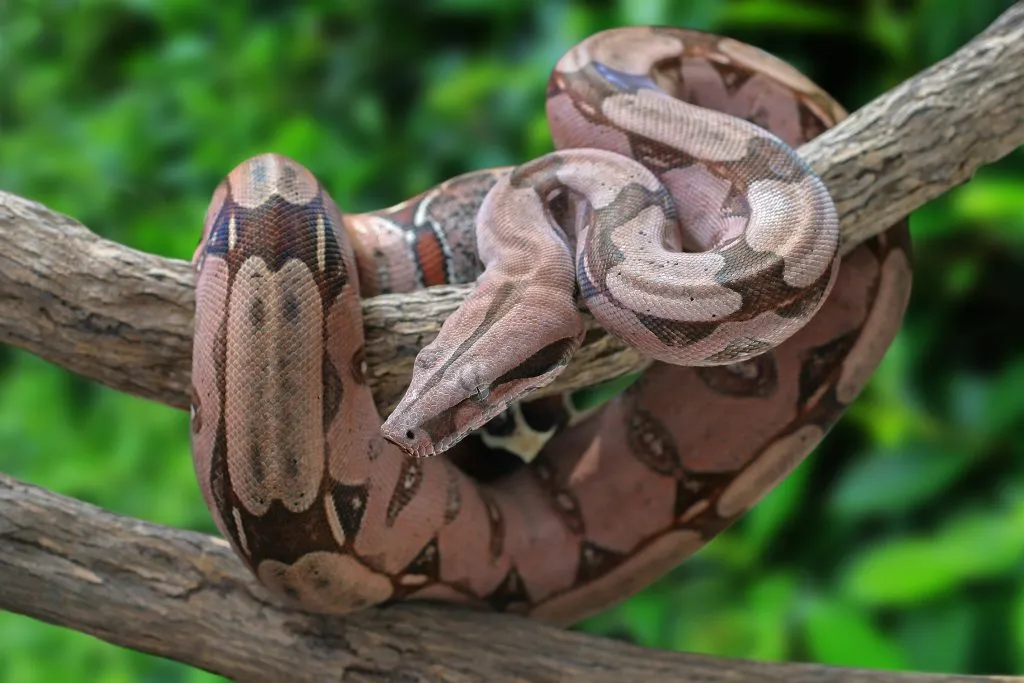
Boa Constrictor Subspecies
There are several subspecies of boa constrictors, and the most common ones are listed below. The Colombian boa, Boa constrictor imperator, is the most common captive-bred boa. All boas generally share similar care requirements.
| Common name | Scientific Name | Description |
| Colombian boa or common boa | Boa constrictor imperator | 21 or more saddles between the head and vent |
| Red-tailed boa | Boa constrictor constrictor | Less than 20 saddles |
| Argentine boa | Boa constrictor occidentalis | 29-30 interconnected dorsal saddles |
How Big Do Boa Constrictors Get?
Boa constrictors are one of the largest species of snakes, with adults typically ranging in length from 6 to 10 feet and weighing up to 60 pounds. Female boas are generally larger than males, with some reaching lengths of up to 12 feet.
Boa constrictors grow rapidly during their first few years of life. Some snakes double in size in as little as 6 months.
It is important to provide a suitably sized enclosure that allows them to move freely and stretch out fully, as cramped conditions can cause stress and health issues.
Boa Constrictor Lifespan
Boa Constrictors can live for up to 30 years in captivity, although their lifespan in the wild is typically shorter due to predation and other factors.
As such, keeping and raising a boa constrictor requires long-term commitment and dedication.
How to Care for Boa Constrictors?
Caring for a boa constrictor involves providing suitable habitat conditions, an appropriate diet, stimulating enrichment, and proper veterinary care to ensure a good quality of life.
Here’s a summary table of what you need to know before we break down each aspect in full detail.
| Enclosure type | Fiberglass, wood, or glass |
| Temperature gradient | Dayt: 82 – 90°F Night: 78 – 85°F Basking: 95°F |
| UVB Lighting | Not necessary but recommended |
| Substrate | Aspen shavings, cypress mulch, coconut coir |
| Humidity | 50-70% |
Tank Size and Setup
Boa constrictors require a spacious
Juvenile boas need an enclosure that is at least 24” long and 15” tall. Adults will need at least a 72” x 24” x 24” enclosure.
Larger enclosures provide more comfortable space to establish temperature gradients and proper ventilation.
Glass tanks are most commonly used for terrariums as they are inexpensive and easy to clean. However, if your budget permits, invest in a wooden or fiberglass enclosure.
These provide better ventilation and give your boa visual security.
Lighting and Temperature
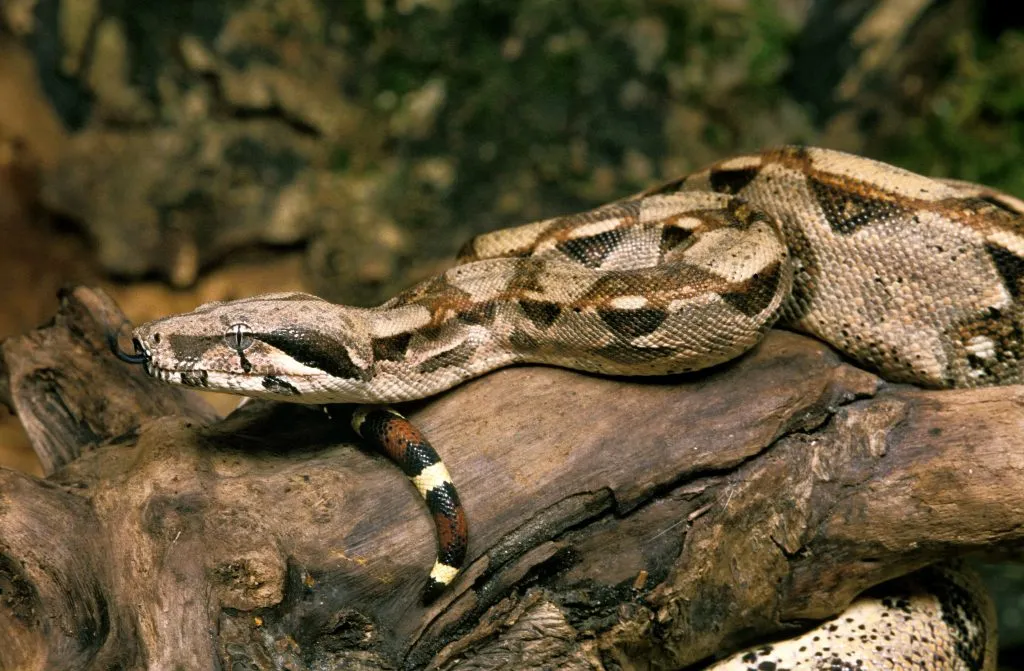
A boa constrictor’s
During the day, the enclosure should be maintained at 82 – 90°F, while it should dip down to 78 – 85°F at night. The basking area can be maintained at 95°F.
The optimal temperature range can vary among boas due to age, sex, and breeding status. You may need to adjust the temperature according to your boa’s behavior.
If it spends too much time in the basking area, try to increase the temperature range. If it stays too long in the coolest area, slightly lower the temperature.
Heat sources can include ceramic heat emitters (like this one), heat mats (like this one), and basking lamps, although light sources should be turned off at night. Heat devices are best maintained with a thermostat. An accurate thermometer should be installed on both warm and cool areas.
Do Boa Constrictors Need UVB?
Boa constrictors are nocturnal creatures in the wild. In captivity, they do not have any special lighting requirements.
Providing broad-spectrum UVB lighting at 290-300 nm is still recommended due to its health benefits. UVB lighting helps reptiles synthesize vitamin D3, which they need for proper calcium absorption by the bones.
Substrate
Aspen shavings, cypress mulch, and coconut coir are great options for your boa. Avoid using cedar and pine shavings, as they can cause respiratory issues in snakes. Granular substrates, on the other hand, can cause impaction in boas when ingested.
Humidity
Because boa constrictors originate from rainforests, they require a high humidity range in their enclosure. Relative humidity should be maintained at 50 to 70% to allow healthy respiratory function and normal shedding or ecdysis.
Boa Constrictor Tank Decor
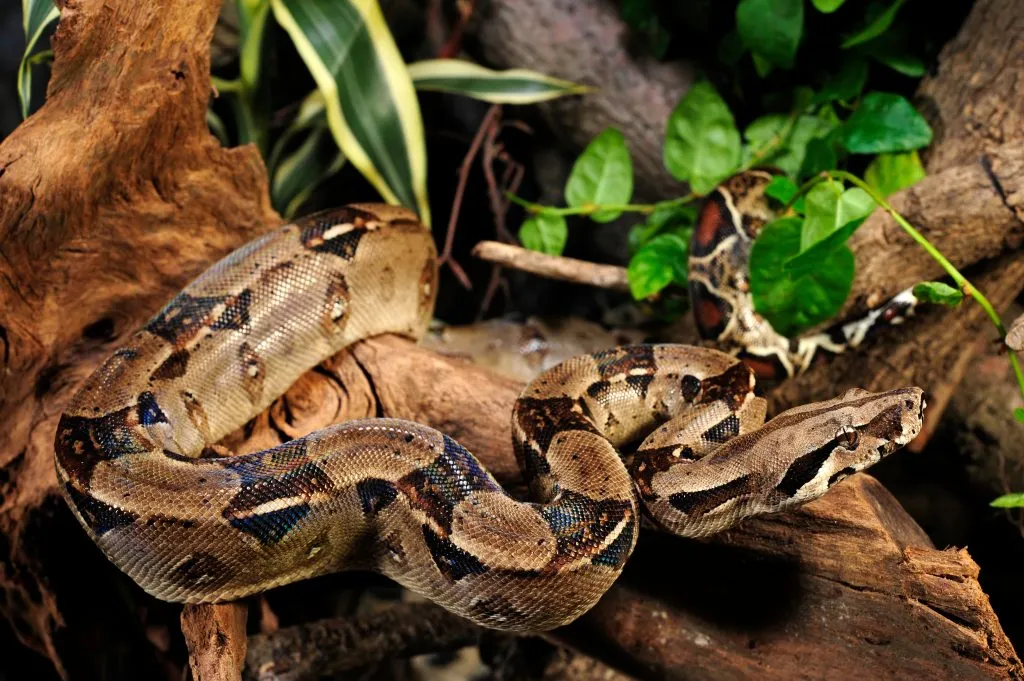
Boa constrictors are active and curious snakes that need plenty of enrichment, hiding spots, and climbing opportunities.
The
Hide boxes filled with moistened sphagnum moss or damp vermiculite can provide a local high-humidity shelter that your boa will enjoy.
Branches, vines, and rocks can be added to provide climbing opportunities. A large thick branch, for example, may serve as the basking spot for this semi-arboreal snake.
However, it’s important to ensure that the decor is securely placed to avoid injury.
How to Clean a Boa Constrictor Tank
Spot-clean the enclosure daily, making sure to remove fecal material, soiled substrate, and shed skin as soon as possible. The substrate should be replaced once a month, and the water bowl should be thoroughly cleaned at least weekly.
The vivarium should be entirely emptied and thoroughly cleaned every three months. The following are suitable disinfectants for your boa’s enclosure. They should ideally be left for ten minutes before completely rinsing.
- Dilute bleach water (1:30)
- Quaternary ammonium compound (see here)
- Povidone iodine
- Other commercial reptile-safe disinfectants
Boa Constrictor Diet
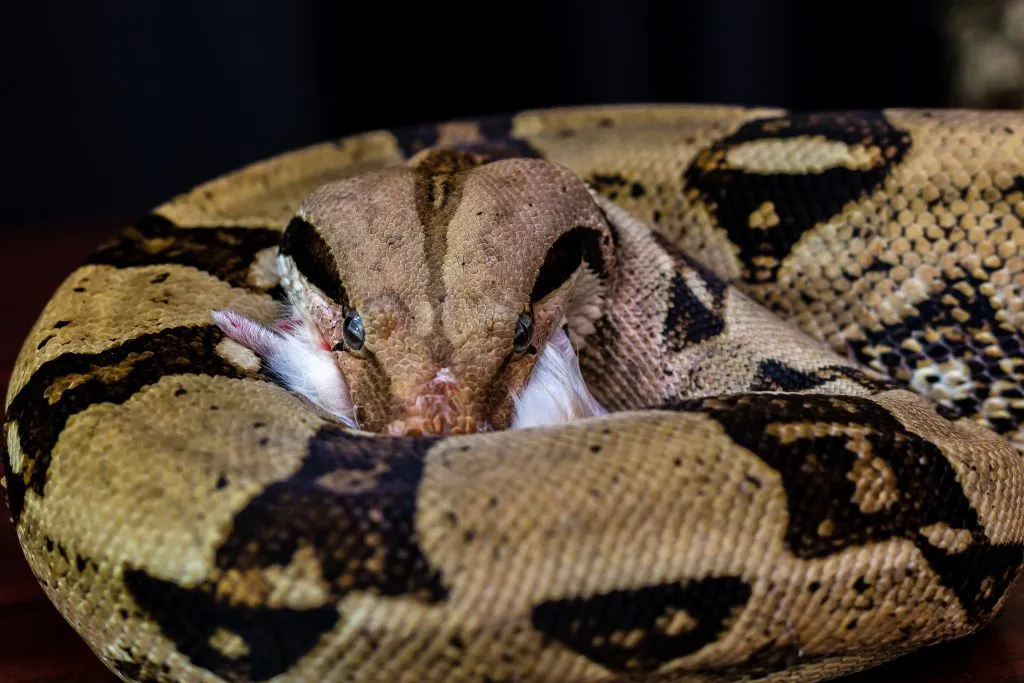
What to Feed
Like all other snakes, boa constrictors are carnivores. They are capable of eating a wide variety of prey in the wild, including birds, small mammals, and other reptiles.
In captivity, a boa constrictor’s diet should consist of appropriately-sized rodents, such as rats and mice. Large adults can also be fed rabbits and guinea pigs.
Prey items should not be larger than the girth of your boa’s midbody. Frozen-thawed mice or rats that are warmed to blood temperature (98.6 °F or 37 °C) are the ideal
They should have been humanely killed and be used within six months of feeding.
Feeding frozen-thawed animals is convenient for owners and is more humane for the prey animals. For your boa, this is also safer, as pre-killed rodents will not cause injuries and parasite transmission that live prey can do.
How Often to Feed
The frequency, size, and volume of feeding are important considerations to ensure that you are feeding your boa constrictor appropriately, and not under- or overfeeding.
Snakes that have adapted well in captivity can become used to eating even when they are not hungry, making them prone to obesity.
Juvenile boas up to 3 feet long should be fed 1 to 2 appropriately-sized mice every 7 days, while larger boas up to 6 feet long should be fed 1 to 2 rats every 7 to 10 days.
Adult boas need less frequent feeding, so you can give rats or a rabbit every 10 to 14 days.
Your boa’s behavior can tell you when they are feeling hungry – when they become more active and move around their enclosure more.
How Long Can Boa Constrictors Go Without Food ?
Generally, healthy adult boas can go without
Do Boa Constrictors Need Water?
Boa constrictors are aquatic creatures. They should have access to fresh, clean water at all times. The water dish should be large enough to allow the snake to soak in. A shallow, wide bowl would be a good choice.
The bowl should be cleaned and water should be changed daily to prevent bacteria and algal growth, especially since boas tend to defecate in their bowls.
Vitamins and Minerals
Boa constrictors can benefit from vitamins and minerals added to their diet to maintain optimum health. Commercial reptile supplements can be dusted on the prey item before feeding.
Multivitamins are especially useful for growing juveniles and breeding females.
Boa Constrictor Behavior and Temperament
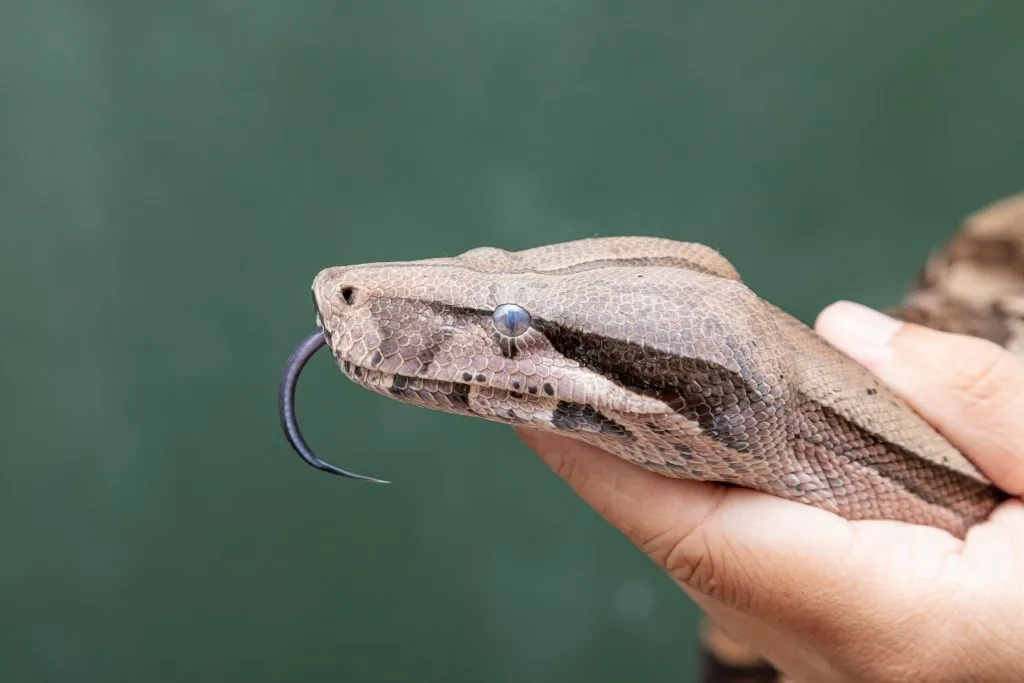
Captive-bred boas are generally docile and easy to handle. However, they can strike when they feel threatened. Their powerful bite can be quite painful.
The Colombian boa is the most docile subspecies, likely because they are the most widely kept in captivity. All boas are non-venomous snakes.
They prefer to be solitary animals both in captivity and in the wild, except during breeding season.
Are Boa Constrictors Good Pets?
Boa constrictors are one of the most popular pet snakes. They make great pets for more experienced reptile enthusiasts because they are relatively low-maintenance compared to other snakes or reptiles.
These active and curious animals are fascinating to observe.
Because of their large size and tendency to violently strike when threatened or alarmed, boa constrictors are not recommended for beginners. Should you decide on getting a boa, keep in mind that they are a long-term commitment.
Regular and proper handling will encourage your boa to be more familiar with human interaction. It can be a very rewarding experience, but it requires patience and confidence.
Before attempting to handle your boa, you must have an understanding of its temperament and behavior to avoid forceful interaction.
When handling, your dominant hand should grasp the boa behind its head, and your other hand should support the rest of its body, like a branch that allows it to climb around on. Larger adult boas are better held by more than one person.
Always use slow and deliberate movements when handling and avoid sudden movements or loud noises that may startle them.
Your handling area should ideally have a table or enclosure, and it should be free of potential hazards or escape routes.
Always wash your hands with soap and water before and after handling any reptile, as they can carry Salmonella, which can cause sickness.
Boa Constrictor Common Health Problems
The most common and serious health problem associated with boa constrictors is inclusion body disease (IBD). It is a viral disease of the brain that usually becomes severe and fatal. Currently, no treatment or vaccine options are available.
Boas with IBD show abnormal neurological symptoms such as head shaking, uneven pupils, muscle spasms that cause the body to arch backward, and regurgitation. Affected snakes also lose their appetite and become lethargic.
The cause of IBD is still poorly understood, however, infection spreads very easily between captive snakes, especially in the presence of snake mite infestation.
To prevent IBD, always quarantine newly acquired reptiles and have them regularly checked by the herp vet for parasitic control.
Where to Buy Boas and How Much Do They Cost?
Purchasing a boa constrictor requires proper research to ensure that you are acquiring from a reputable source. Avoid buying from pet stores or online marketplaces, as these places may not have the expertise to properly care for the animals they sell.
Snakes at Sunset offers a wide variety of boas for as low as $70. Snake Country breeds and produces various morphs that cost anywhere from $350 to $8,500.
Blumen Boas are proud to have produced some of the first types of morphs in the world.
When you’re ready to buy, make sure to ask the breeder about the animal’s health history, feeding habits, and any specific care requirements. Most reputable breeders will be happy to share with you some advice on care and maintenance.
Boa Constrictor Breeding
Boa constrictors reach sexual maturity at 3-5 years old. Breeding them can be a rewarding but challenging endeavor, and will require thorough research and utmost care and attention.
Female boas also require a cooling period before breeding, which can be challenging to manage in a captive environment.
Female boas enter a gestation period of 100-120 days and are viviparous creatures. They give birth to live young that come out from the eggs inside the mother’s body.
Boas typically give birth to a large litter of neonates (25 on average).
- Enchi Ball Python: A Unique and Stunning Morph of Python regius - March 27, 2025
- Emerald Tree Monitor: The Enigmatic Green Guardian of the Rainforest - March 26, 2025
- The Egyptian Cobra (Naja haje): A Fascinating Serpent - March 25, 2025
